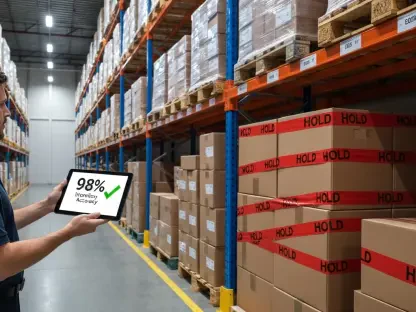As we approach 2025, warehouses are expected to undergo rapid and transformative changes, driven by advancements in technology and the growing demands of e-commerce. These changes will impact everything from warehouse locations and operations to the integration of sophisticated tools and systems designed to enhance efficiency and sustainability. The future of warehouses looks promising with the advent of automation, artificial intelligence (AI), and real-time data integration, which will collectively reshape the way warehouses operate.
The evolution in warehouse operations will not only streamline processes but also address labor shortages and increase overall productivity. The advent of technologies such as robotics and IoT sensors will direct the future of warehouse management, promoting a seamless and efficient workflow. The demand for faster delivery times coupled with heightened consumer expectations will necessitate these advancements to ensure timely and accurate shipments. Furthermore, the increasing focus on sustainability and energy efficiency will prompt warehouses to adopt green practices, rendering them more environmentally friendly. This transition is pivotal as warehouses strive to meet both regulatory requirements and consumer expectations in the evolving landscape of e-commerce.
Technological Evolution in Warehouses
Technological advancements in warehouses are set to go beyond traditional warehouse management systems. By 2025, warehouses are anticipated to witness a surge in the implementation of automation, robotics, and AI. These technologies will be pivotal in streamlining warehouse operations, particularly in areas such as predictive analytics and space utilization. The adoption of robotic systems will enhance the efficiency of picking, packing, and material handling operations. This shift will address labor shortages by easing the challenge of finding qualified workers in certain regions.
The integration of real-time data through IoT sensors will further revolutionize warehouse operations. These sensors will provide critical insights into inventory levels, warehouse conditions, and shipment tracking, allowing for improved decision-making. The increasing demand for faster deliveries, driven by consumer expectations, amplifies the need for real-time data to avoid penalties and ensure timely shipments. With AI algorithms analyzing vast amounts of data, warehouses can predict trends, manage logistics more effectively, and optimize space usage. These technological evolutions promise not only to enhance operational efficiency but also to ensure that warehouses can meet the dynamic needs of e-commerce and consumer demands.
Safety Enhancements
Safety has always been a top priority in warehouse operations, and technological advancements are set to enhance this further. Companies are developing applications to improve forklift and pedestrian safety in warehouses. For instance, forklift-pedestrian safety systems using precision Ultra-Wideband (UWB) technology are designed to detect pedestrians near forklifts and provide audible and visual alerts to operators. This system ensures that forklifts operate at safe speeds and alerts pedestrians through vibrations in their personal protective equipment (PPE).
This advanced technology significantly reduces the risk of collisions and enhances overall safety standards within the warehouse environment. The emphasis on safety is critical, given the potential hazards associated with forklift operations and the need to protect both workers and equipment. Enhancements in wearable technology for workers and machine learning algorithms to predict potential hazards will also contribute to safer warehouse environments. Management systems equipped with real-time monitoring tools will ensure compliance with safety protocols and immediate response to any safety breaches, providing a secure working environment. As these safety measures integrate more deeply into warehouse operations, the industry will see a significant reduction in workplace accidents, fostering a secure and efficient working atmosphere.
Sustainability and Energy Efficiency
Sustainability and energy efficiency are emerging as top priorities for warehouses. As environmental concerns grow and regulations become more stringent, warehouses are under pressure to adopt green energy solutions. The EPA’s “Warehouse Indirect Source Rule” (Rule 2305) is a prime example, aiming to reduce pollution from mobile sources like delivery trucks and refrigeration units. Warehouses must comply by implementing strategies to earn points or pay mitigation fees, with the number of points based on annual truck trips.
To meet these environmental goals, warehouses are adopting various energy-efficient practices. Using sensors and algorithms to manage lighting, temperature, and airflow based on occupancy can maximize efficiency and reduce energy costs. AI-driven systems can predict equipment failures and adjust energy consumption based on demand. These strategies not only contribute to sustainability but also help warehouses manage high energy costs effectively. Optimizing yard operations presents another significant opportunity for enhancing sustainability. AI-based monitoring can streamline gate and yard processes, reducing truck idling time and minimizing fuel consumption. Moreover, AI technology can track and manage pallets, ensuring efficient space utilization and reducing unnecessary forklift trips within the warehouse.
The transition towards greener practices is essential to meet global sustainability goals and comply with increasing environmental regulations. Warehouses incorporating renewable energy sources such as solar panels and wind turbines will significantly reduce their carbon footprints. Additionally, eco-friendly materials in warehouse construction and retrofitting existing structures for energy efficiency will further contribute to sustainability efforts. Effective waste management systems and recycling programs will become standard practices, making warehouses not only energy efficient but also environmentally responsible. These efforts will position warehouses as key players in the global move towards a more sustainable and eco-conscious future.
Impact of E-commerce
E-commerce continues to exert a significant influence on warehouse operations, dictating new design and operational needs. The need for strategic locations, smaller regional facilities, and support for omnichannel fulfillment has transformed warehouse designs. Micro-fulfillment centers, small localized warehouses positioned near urban areas, have emerged to meet the demand for faster, more efficient order fulfillment. These centers enhance last-mile delivery efficiency, ensuring products reach customers quickly, thus improving customer satisfaction.
The growth of e-commerce has also led to an increase in reverse logistics—the process of returning goods. Effective reverse logistics systems have become essential in supply chain management. This necessity was underscored in January when DHL Supply Chain acquired Supply Chain Solutions, a division of Inmar Intelligence. The acquisition, which added 14 return centers to DHL’s North American operations, highlights the importance of an integrated approach to managing returns. This acquisition strengthens DHL’s capabilities and allows them to offer a single-source solution for the entire supply chain, including the complex area of returns management.
Adapting to the e-commerce boom has forced warehouses to rethink storage solutions, with vertical storage systems and advanced sorting technologies becoming more prevalent. With the trend towards personalization in retail, warehouses must quickly adapt to consumer preferences, making technology-driven flexibility a cornerstone of modern warehouse operations. Efficiently managing high volumes of diverse and rapidly changing inventories is imperative to meet the speed and accuracy e-commerce demands. This necessitates integration with sophisticated inventory management systems and automated picking solutions to keep pace with consumer expectations. As e-commerce continues to grow, warehouses will need to innovate continually to maintain competitiveness and deliver exceptional service to the end customer.
Overarching Trends
The holistic overview of the article reveals several overarching trends shaping the future of warehouses:
- Technological Integration: Warehouses will increasingly integrate advanced technologies like AI, robotics, and IoT to enhance efficiency, accuracy, and safety in operations.
- E-commerce Influence: The ongoing rise of e-commerce will continue to drive changes in warehouse design, location, and operational strategies, emphasizing the need for faster, more efficient order fulfillment and robust reverse logistics systems.
- Sustainability Efforts: Sustainability and energy efficiency will become crucial, with warehouses adopting green practices and technologies to meet regulatory requirements and reduce operational costs.
- Safety Improvements: Technological advancements will significantly improve safety standards within warehouses, minimizing risks associated with material handling and transportation.
Conclusion
As we near 2025, warehouses are poised for rapid and transformative changes, spurred by technological advancements and the escalating demands of e-commerce. These evolutions will influence everything from warehouse locations and operations to the deployment of advanced tools and systems aimed at boosting efficiency and sustainability. Automation, artificial intelligence (AI), and real-time data integration will collectively revolutionize warehouse operations.
This transformation will simplify processes, address labor shortages, and enhance overall productivity. Technologies such as robotics and IoT sensors will play a critical role in shaping the future of warehouse management, fostering streamlined and efficient workflows. The imperative for faster delivery times and rising consumer expectations will drive these advancements, ensuring timely and accurate shipments. In addition, the growing emphasis on sustainability and energy efficiency will push warehouses to adopt environmentally friendly practices. This shift is crucial as warehouses seek to satisfy both regulatory standards and consumer expectations in the ever-evolving e-commerce landscape.









